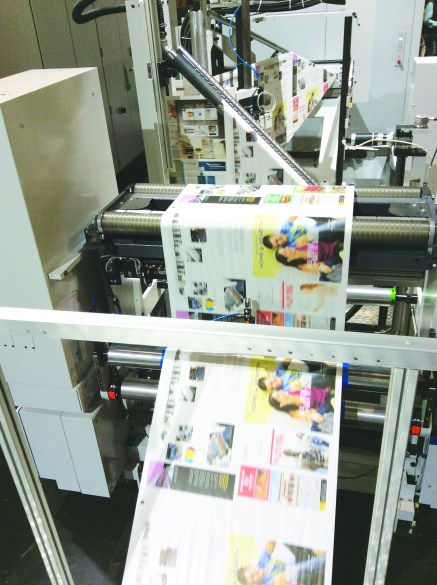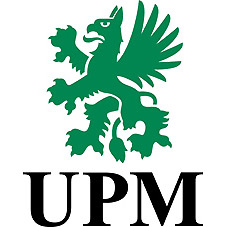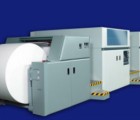
Continuous feed high speed inkjet threatens to shake up the printing industry.
The technology’s makers feel they have done enough for high speed inkjet it to step up and take its place as a mainstay in commercial printing operations. But, whether that happens in two, five, or 10 years depends on a range of factors, not all within the manufacturers’ control. As always price, quality, and productivity will play their part in business owners’ and managers’ decisions.
The other major factor in how soon it becomes more common – where best to place the technology – will determine the rate at which it gets picked up. So far, transactional documents, book printing, and a range of less popular applications have occupied high speed inkjet but, as the quality increases, we can expect to see more crossover. Should the price come down, then we can really expect some radical change.
Manufacturers like Canon, EFI, Fuji Xerox, HP, Kodak, Ricoh, and Screen have done more than dip their toes in the inkjet pond. They have made considerable investment in research and development and we can expect to see more. They have to believe that, at some point, a significant number of print operations will select high speed web fed inkjet over lithographic printing. There are
at least half a dozen developers with continuous feed inkjet systems.
Canon Océ Prostream
Eearlier this year Canon Océ launched Prostream, a continuous feed production inkjet system targeting the mid-to-high volume commercial printing market.
The company says it has designed the Prostream from the ground up to print at 80 metres per minute on a 565mm web. With native 1200dpi heads utilising Digidot technology and the advantage of our ColorGrip technology with polymer pigment ink, Canon says the Prostream can produce high quality results on a large range of uncoated and coated non-treated inkjet substrates.
The Océ Prostream offers a high productivity duty cycle of 35 million A4 sheets per month and offset like colour gamut with the versatility of fully variable digital output. Combined with a large range of inline finishing options the Océ Prostream can produce anything from B2 sheets to a perforated, saddle stitched or glue bound booklet trimmed to size.
Canon says, “With the Océ ProStream, you can benefit from broad substrate support and format versatility up to B2 sheet size, plus support for coated or uncoated media. This continuous feed press fits seamlessly into workflows, allowing easy integration into existing PDF workflows, IPDS and PDF DFE, plus an intuitive, modern user interface.”
Canon Océ is market leader in continuous feed inkjet, it has bene in the market for the longest and has the biggest range of solutions.
EFI Nozomi
The EFI Nozomi C18000 printer, easily the company’s largest inkjet product development, targets lower costs and higher productivity in digital corrugated packaging.
It is a sheetfed printer, but with a high throughput, it prints at speeds of up to 75 linear metres per minute, producing up to 9000 80 x 60cm boards per hour. At 1.8m wide, this single-pass printer will find a place in print shops looking to profit from what is a new market of short-run, on-demand corrugated work. Offering up to seven colours, including white, at a 360 x 720dpi resolution, it handles materials of up to 1.8 x 3m and thicknesses up to triple-wall board at full rated speeds.
EFI calls Nozomi transformative. The company sees a big future for the technology, delivering more than applications for short runs, quick turnarounds and versioning and personalisation. EFI has identified growth coming from emerging applications that cover more than posters, signage and billboards. It says that UV-curable, water-based inkjet printing continues to show increasing growth and EFI technological advancements now offer more speed, higher resolutions and more substrate options.
These include printing on packaging, plastics and ceramics to laminates, textiles, interior design and décor, and personalised and customised short-run graphics. EFI says its UV-curable technology gives print providers a high level of flexibility and versatility, with the ability to print on nearly any type of substrate.
HP T400
WITH more than 25 installations worldwide, HP believes its inkjet web press systems will help to change the business dynamics of applications such as publishing, transactional printing and direct mail.
At 183 metres per minute, the HP T400 colour inkjet web press prints up to 5200 full-colour, letter-size pages per minute. For colour quality, the HP T400 uses what it calls High Definition Nozzle Architecture (HDNA) which has 2400 nozzles per inch native resolution and dual drop weight.
The press continuously monitors and actively adjusts colour to colour registration to provide consistent quality throughout a run and has a set of on-press and prepress colour management tools, including the HP SmartStream Color Studio. Automated quality control features include the optional HP Quality Image Check Vision System, which monitors nozzle health by selectively comparing the rip output to the printed image.
Other features include magnetic ink character recognition (MICR) system; ability to handle third-party coated media; workflow and finishing solutions from the HP Graphic Solutions Partner programme; advanced web tension controls and dryer systems.
HP says with standard size web press, finishing equipment can produce two jobs simultaneously on the HP T400, using an optional slitter at the end of the press to convert the roll into side-by-side webs. HP offers customers an option to upgrade HP T300 presses to the faster T350 platform.
Kodak Prosper
Described as an output workhorse, the Kodak Prosper 6000 produces up to 90 million pages per month. With advanced rollers, air-based turnbars, and air management system, substrates move through the press at lightning speeds.
It uses a low-friction, error-assist turnbar with no replaceable sleeve and no wear component, for less operator intervention. Its air management system uses air knives to take warm air out before it has a chance to condense on cooler surfaces on the press. This prevents condensation as the web is heated (it creates warm, moist air as the water-based ink dries).
Profiled rollers, situated at strategic locations across the entire paper path, aid wrinkle prevention, so it reduces imperfection.
Both the out-feed drive and the in-feed drive have a high-grip, plasma-coated drive roller and a full-width solid nip roller on the out-feed. Key rollers are designed to help maintain consistent tension on the web. That means fewer imperfections like mis-registration and wrinkles.
The company says that new-generation ink droplet technology on the Prosper 6000C (cited as almost triple the speed of traditional drop-on-demand) opens new opportunities for production inkjet, such as long-run variable-data printing. The Prosper achieves up to 200lpi – quality that exceeds current inkjet technologies.
Ricoh Infoprint
For its Infoprint press, Ricoh offers two platforms: GP for general production and MP for multi-purpose. Ricoh says its proven inkjet technology has systems in production around the world, and it has Pantone Plus certification.
You can configure the InfoPrint 5000 MP press as a high-speed double-sided mono or entry-level duplex colour system. They target colourful transactional and promotional documents, book printing, and direct-mail projects. Ricoh says the The InfoPrint 5000 GP platform suits environments with tight print windows and requirements for diverse media and stringent colour quality.
The InfoPrint 5000 GP press offers full-colour, monochrome and MICR printing on a range of paper stocks and at a variety of speeds.
Ricoh says colourful graphics and personalised printing makes information easier to understand, which can help open new revenue opportunities in fast-changing markets. Ricoh says the speed of all models can be upgraded in the field.
They can get MICR support in colour or monochrome configurations, with PostScript, PDF, or AFP / Intelligent Printer Data Stream using the GP alone or paired with the InfoPrint MP MICR model. Ricoh’s ink management suite improves accuracy of print job estimates and monitoring ink usage. Ricoh says the Advanced Function Presentation print architecture targets gain page-level error recovery and delivers accurate, device-independent output.
Screen Truepress
After a decade of production, Screen has extended its Truepress Jet520 range with the NX variation and the HD model that uses new inks, called SC for commercial-quality printing on coated papers.
The Jet520NX features new five-inch printheads capable of 600 x 1200dpi. The company has accelerated the machine’s speed to a blistering 150 metres-per-minute. An optional extra printhead allows for the use of MICR black ink, invisible UV fluorescent ink, and other inks.
With the Jet520HD, Screen has targeted commercial print, rather than transactional and direct mail. It accepts a paper range of 40gsm through to 250gsm, with a wide gamut ink set Screen says rivals offset. It has three different speed settings to balance print quality requirements and meet production deadlines. At the top speed of 120m per minute, the Jet520HD produces around 1600 A4 pages per minute. At 50m per minute, full 1200dpi by 1200dpi resolution is used, combined with smooth halftone reproduction of four grey levels. Screen says this means the press can deliver stunning vibrant colour and sharp text resolving power.
When not if
High speed inkjet manufacturers see global acceptance of their machines as inevitable; just a matter of time.
They have poured huge amounts of money into research and development and no doubt more advancements will follow. However, all that development comes at a price; these machines won’t pop up at your local copy shop.
The latest continuous feed high speed inkjet presses have made massive improvements across the board and have attracted strong interest from a range of print companies; not just those doing transactional and direct mail work. As the technology continues to evolve, we can expect to see more installations. But only time will tell if this technology can seriously challenge lithographic printing.
Comment below to have your say on this story.
If you have a news story or tip-off, get in touch at editorial@sprinter.com.au.
Sign up to the Sprinter newsletter



